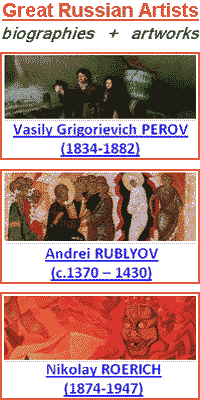The Tale of Peter of the Horde
The Life of St Peter, Prince of the Horde was also a vita-cum-tale, based on oral tradition. The hero is a pious Mongol prince who lived in the Horde, heard a sermon by an Archbishop who had come to visit the Mongols, and was baptised and given the Christian name of Peter. Peter moved to Rostov. On the shore of Lake Nero the Apostles appeared to him in a dream, gave him two sacks of gold and ordered him to erect a church with the money. The Apostles also appeared to the Bishop of Rostov in a dream and ordered him to help Peter. To build the church Peter needed the permission of the Prince of Rostov, but the latter demanded in payment for the land on which the church was to be built the number of gold coins that could be placed along the edge of the land. Peter agreed. He acquired a piece of land by the shore of Lake Nero, dug a ditch round it, as was the custom in the Horde, and placed so many coins along the boundaries of his land (taking them from the magic sacks), that they filled the carts and chariots sent by the prince. When the church was built the prince persuaded Peter to marry and live in Rostov. After Peter’s death “at a ripe old age” a monastery was built on the spot where the Apostles had appeared to him. The rest of the vita tells of the fate of this monastery and Peter’s descendants and describes the disputes between them and the townspeople of Rostov over the lake which was on the monastery’s land.
Both the plot, which lacks the martyrdom and suffering for the faith typical of vitae, and its individual images are far removed from traditional Lives. The figure of the Rostov prince who gives Peter the land for the church and the monastery is very interesting. Unlike the devout Mongol prince, he is a shrewd, cunning politician. To the “horror” of Peter and the Archbishop of Rostov he derides the appearance of the Apostles, openly mocking Peter: “The archbishop will build you a church, but I won’t give you a place for it. What can you do about that?” Free from earthly cares, Peter replies meekly: “At the command of the Holy Apostles, Prince, I shall buy from you however much land your grace will grant unto me.” Hearing these words and seeing the sacks of money in Peter’s hands, the prince decides privately to profit as much as possible from the “horror” of the other two men and extract lots of money (which he does). His subsequent behaviour is of an equally practical nature, i.e., the decision to keep the christened Mongol in Rostov: “If that man, the kinsman of rulers, goes back to the Horde, it will be a loss to our town… Peter, shall we get you a bride?” Peter accepts the offer and stays in Rostov.
One of the main motifs in the tale, the excessive price asked by the prince for the plot of land and the magical way in which Peter complies with this condition, is obviously derived from folklore. The same applies to the account of the dispute over the lake in the second part of the vita. This dispute begins with an unusual contest between the fishermen from the town and the monastery (Peter’s) fishermen. The monastery fishermen catch more fish than the town fishermen. Peter’s men cast their nets almost playfully and bring in a great haul of fish, but the town fishermen labour hard and catch nothing. Incensed by the insult to their fishermen, the prince’s descendants decide to deprive Peter’s descendants (the owners of the monastery’s land) of the right to fish there, arguing that their forefather sold Peter the land, but not the lake. The settlement of this dispute is again typical of oral tradition. The Mongol khan’s envoy appears in the role of the fair arbiter. He asks the Rostov princes if they can take the water away from the land granted to Peter. “The water is our patrimony, but we cannot take it away, Sir,” the princes reply. “If you cannot take the water away, then why do you call it yours?” the envoy concludes.
Like The Life of St Michael of Klopsk, The Life of St Peter of the Horde was revised in the next century. The redactors were troubled by the unusual figure of the Prince of Rostov, Peter’s patron. Whereas in the original redaction he spoke of his desire to “extract” lots of money from the Mongol prince, in subsequent revisions he himself gasps “with terror” at the vision seen by Peter and the archbishop, although he demands an exorbitant price from Peter for his land. His desire to keep Peter in Rostov is explained not by practical considerations, but by the pious fear that Peter will renounce Christianity.
But these were later revisions of the hagiographical tales. In the fifteenth century the tnfae-cum-tales were a fairly widespread type of Life: their engaging plot, humour, folklore and motifs from everyday life brought them closer to the secular tales of the fifteenth century.
 History of Russian Literature
History of Russian Literature
